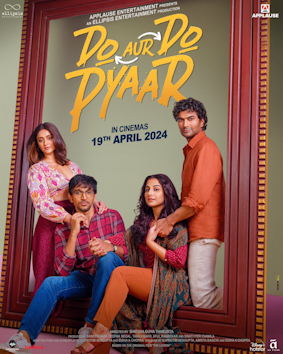
Do Aur Do Pyaar — A Raw, Realistic Take on Modern Love and Marriage
Do Aur Do Pyaar marks the much-anticipated return of Vidya Balan to the big screen, delivering a performance as Kavya that is nuanced and deeply relatable. Directed by debutant Shirsha Guha Thakurta, the film also stars Pratik Gandhi as Ani, who complements Vidya with a portrayal full of subtlety and emotional depth. Together, they bring to life the story of a love marriage that has quietly slipped into indifference.
A Marriage Drifting Apart
The film opens with Kavya and Ani existing side-by-side in their shared home, but emotionally distant—once deeply connected, now barely exchanging more than superficial pleasantries. The narrative delicately explores their silent suffering and the complicated emotions that lead both to seek comfort outside their marriage. However, neither has the courage to confront the truth or initiate a breakup, symbolizing the complex hesitation many couples experience.
This portrayal resonates deeply because it’s a reality many couples face: a marriage without conflict, yet devoid of warmth or connection. A sudden family death becomes the catalyst for Ani to accompany Kavya back to her childhood home, rekindling old feelings and stirring turmoil with their new partners. The story captures the messy, complicated nature of love and commitment.
Vidya Balan’s Powerful Performance
Vidya Balan’s Kavya is especially compelling—her struggle between past wounds and present realities feels authentic. Scenes of Kavya confronting her father are raw and truthful, highlighting the ambiguous and flawed relationships many of us share with our parents.
Pratik Gandhi as Ani
Pratik Gandhi’s Ani balances duty and desire with a performance that feels restrained yet emotionally charged. The chemistry between the leads enriches their portrayal of a troubled couple, full of unspoken words and simmering tensions.
Realistic Reactions to Betrayal
One of the film’s most memorable moments is when Kavya and Ani discover each other’s affairs. Their reaction—marked by anger and hurt rather than calm maturity—rings true to human nature. Both flawed and vulnerable, their responses remind us that love is often imperfect, messy, and deeply emotional.
Generational Perspectives on Relationships
While older viewers may find the themes unsettling, reflecting concerns about shifting societal values, younger audiences might see the film as a mirror to contemporary struggles in relationships. This generational divide underscores how perceptions of love and marriage evolve over time.
Direction and Authenticity
Shirsha Guha Thakurta’s debut direction opts for subtlety over melodrama, giving the film an intimate feel. Small, thoughtful touches—like the characters addressing each other by surnames or the cultural flavor of Tamil phrases and Bengali dishes—add richness and authenticity.
The Message: More Than Just Love
Do Aur Do Pyaar makes a clear statement: love alone isn’t enough to sustain a relationship. Respect, compromise, and continuous communication are the true foundations. It’s a gentle reminder that maintaining a marriage is about everyday effort and understanding.
A Soundtrack that Enhances Emotions
The film’s music is a standout, featuring artists like Lost Stories, The Local Train, and When Chai Met Toast. Lucky Ali’s comeback song Tu Hain Kahaan adds a nostalgic layer, perfectly complementing the film’s emotional undertones.
Conclusion: A Thought-Provoking Watch
Do Aur Do Pyaar may not be flawless. Certain elements leave room for more exploration. But its honest dive into love, loss, and the complexity of marriage makes it a thought-provoking watch.
Whether you agree with Kavya and Ani’s choices or not, the film’s willingness to explore uncomfortable truths is what makes it a must-watch. If you’ve ever been in love or pondered what keeps couples together, this movie will strike a chord.
Like our content? Please support us by sharing and up-voting!
Image Credits: Wikipedia
